Climate Change Facts and Impacts (Part 2 of 4)
Ø What are the expected effects of anthropogenic Climate Change?
This question has already been partially answered, climate change is already happening and around the world vulnerable communities, ecosystems and nations are feeling the impacts. To answer this question effectively it is necessary to look at two questions, each from an environmental and a human perspective:
1. What changes have already been observed?
2. What changes can we expect if emissions continue in an unmitigated fashion?
1. What changes have already been observed?
The Cryosphere (all the frozen stuff)
Many of the most prominent changes that are already occurring are doing so in the arctic region. The reason for this is strong positive feedback associated with occurs with ice and snow melt. As we all know ice and snow are highly reflective and white, for this reason, when the ground or ocean beneath is revealed more absorption occurs. This leads to further warming…further melting etc… The pictures bellow show the effects of climate change in recent years. The reduction of sea ice since 1979 is quite striking, but as I will show latter the predictions for changes over the next one hundred years are far more dramatic.
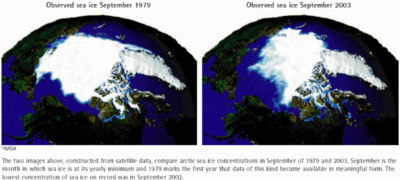
A recent conference on climate change was held in Greenland, this was no accident; the melting of the Greenland ice cap is one of the most potent symbols of human impacts on the planet. The Pictures below show the increase in melting that has started to occur between 1992 and 2002. Clearly the level of warming currently occurring in the arctic is having an enormous impact on the region and the magnitude of further warming is set to be disastrous for the region, as the Arctic Climate Impact Assessment (ACIA) states:
“The reduction in sea ice is very likely to have devastating consequences for polar bears, ice-dependant seals, and local people for whom these animals are the primary source of food”
The ACIA is a major contribution to our understanding of the climate change in the arctic; it utilizes the latest climate science, satellite and temperature data along with the experiences and cultural knowledge of the indigenous peoples.

The effects of climate change are very important to people who depend so directly on the land, an indigenous Siberian woman voices concerns typical of the people in the high arctic:
“Nowadays snow melts earlier in the spring time and the lakes, rivers and bogs freeze much latter in the autumn. Reindeer herding becomes more difficult as the ice is weak and may give way… all sorts of unusual events have taken place. Nowadays the winters are much warmer than they used to be. Occasionally during the winter time it rains. We never expected this. It is very strange…the cycle of the yearly calendar has been disturbed greatly and this effects the Reindeer herding negatively, for sure”
Throughout the world losses of ice and warming have been affecting peoples livelihoods. Glaciers throughout the temperate and tropical regions are being particularly hard hit. In Austria for example this glacier (fig.10) has disappeared between 1875 and 2004. Large areas of taiga forest (fig.9) are also being effected by climate change, they are drowning and rotting as the permafrost on which they grow is melting and turning to anoxic sludge which can no longer support the trees.
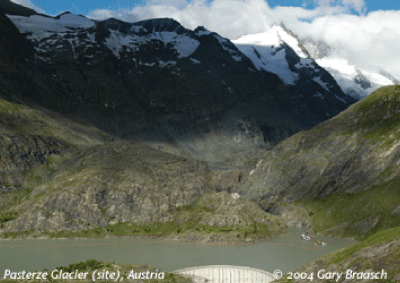

The loss of glaciers in itself is a huge problem; there is usually a balance between accumulation during the winter and melting during the summer. Glaciers therefore act as a buffer against low river flows that would typically occur during the summer. This melt water is crucial for tens of millions of people around the world. Many of the most vulnerable are subsistence farmers, who are now facing crisis and the more warming that we allow to happen the more people will be affected. This demonstrates the fact that fighting climate change is not an activity in competition with fighting poverty; it is key to fighting poverty!
The Oceans
The main reason for the rise in sea level that has occurred so far and that will continue in the medium term is thermal expansion; warm water is less dense and takes up more room. The response of the oceans to the warming effects of climate change is however relatively slow, this is due to several factors, the enormous volume of the oceans, the high heat ‘thermal capacity’ of water (water takes more energy to heat per unit mass than virtually any other substance) and the and the relatively slow rate of mixing between the surface and deep ocean waters. It is for this reason that: The oceans haven’t yet wiped out the whole of the Maldives and; It is now impossible to prevent the ocean from rising further, although the levels of future warming will determine the exact extent of sea level rise that will occur. One of the most sensitive nations on earth to rising sea levels is the Maldives, a nation of small atolls, islands formed by millions of years of coral growth. Already the state is losing some land such as the ‘island’ in the picture below (fig.11), all of the plant life on which has now been removed by repeated flooding as the sea levels rise.
An increasingly El Nino like state to the oceans is also likely to occur. The El Nino event is a complex pattern of atmospheric and ocean interactions, and its effects are felt across the tropical and sub-tropical regions. There are many consequences to this cyclical event including failing of the cool nutrient rich ocean waters which well up along the west coast of south America. These currents usually make this region one of the most productive areas of ocean in the world; productivity on which much of the wildlife living along the Pacific coast of South America are dependant.
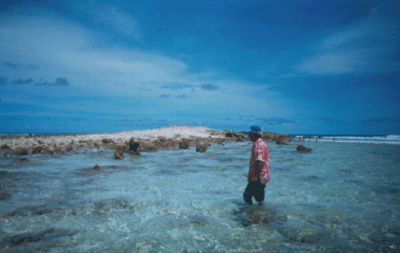
El Nino events in recent years have acted to compound human damage to coral reefs worldwide. Coral bleaching is caused by increased stress, abnormally warm temperatures being an example of such a stress. The El Nino events of recent years have been some of the worst in history. A state close to El Nino becoming the norm is likely to be devastating for the corals worldwide. The pictures below (fig.12) illustrate the impact of irrevocable bleaching; the ‘Amazon of the sea’ becomes a virtual desert.
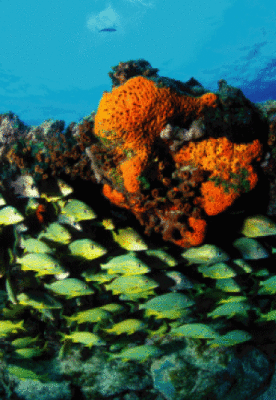

The Biosphere (everything that lives)
“There is no realistic doubt that continued climate change will cause further degradation of coral reef communities, which will be even more devastating in combination with the continuing non-climatic stresses that will almost certainly increase in magnitude and frequency”
(Pew Center on Global Climate Change)
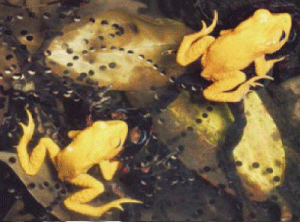

The loss of coral ecosystems is a disaster both environmentally and economically.
“Coral reefs represent some of the most biologically diverse ecosystems on Earth, providing habitat for approximately 25% of marine species. In addition, these ecosystems provide economic benefits through tourism and fisheries. One recent estimate valued the annual net benefit of the worlds coral reefs at 30 $ billion.”
(Pew Center on Global Climate Change)
Some of the first species losses to have been attributed to climate change are the collection of around 70 species of harlequin frog (fig.13) Genus Atelopus, Endemic to Central and South America. (J.Alan Pounds and Robert Puschendorf, Nature, 2004)
A recent report on climate change observations in the USA by the Pew Center for Global Climate Change found that e.g. laying, flowering, migration and breeding of a diverse range of flora and fauna where all occurring earlier in the season (fig.14). All these effects are known as Phenological phenomena, some of them are shown in the table below.
Weather Patterns (The direct effects of a changing climate on humans life)
Sub-Saharan Africa is one of the areas feeling the effects of climate change most keenly at present. The Sahel region is particularly vulnerable. A region defined by its sparse forests and widely separated trees, seasonally rich grassland is crucial for feeding the cattle of the indigenous nomadic peoples. The variation in annual rainfall has long been a strong influence on the way of life these people have evolved. On the southern margins of the Sahara however climate models predict problems ahead. Indeed rainfall has historically been widely variable, but over the last 30 years the average rainfall has fallen by 25% and this has forced the proud tribes people of Kenya to become dependant on international food aid. Other areas affected include the Sudan, Ethiopia many individual situations have received significant media coverage; a changing climate is the central theme. Another prediction made by climate models and subsequently supported by weather stations is that there will be an increase in the proportion of rainfall that occurs in intense bursts.
“Most countries that experienced an increase or decrease in monthly or seasonal precipitation also experiences a disproportionate change in the amount of precipitation falling during heavy or extreme precipitation events”
(David R.Easterling et.al., Science 2000)
The burden of the climate change is falling disproportionately on the already poor, particularly in Southern and Central Africa. The effects of on human health are just beginning to bite. The world health organization (WHO) estimates that:
“Climate Change is currently causing the loss of around 5.5 million years of healthy life per year, equivalent to 150`000 lives lost annually.” This chart shows the numbers of ‘disability adjusted life years’ per million population due to climate change (right) and air pollution (left) WHO report 2002
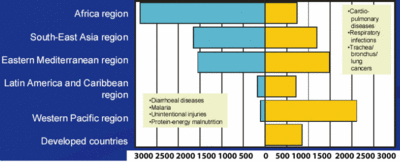
More ‘developed’ countries are however still susceptible to the effects of climate change. Across Europe in the summer of 2002 a record-breaking heat wave caused tens of thousands of deaths(fig.16), particularly in France. Although single weather events cannot be usually be attributed to climate change there was a detailed study carried out into the heat wave, its extent and severity. This study published in the journal Nature found that the chances of the summer heat wave occurring without climate change where less than one in a thousand.

This table shows the area affected by the heat wave and the chart on the right shows the daily maximum and minimum temperatures along with the number of deaths on the bar chart.
----------------------------------------------------------------------------------------------
This is part 2 of 4 in a series of articles on climate change part 1 of 4 is here.
1. Basic Science of Climate Change.
2.Effects of Climate Change so Far.
3.Future impacts of Climate Change.
4. Level of emmisions reductions required.
The series a a whole can be downloaded in PDF fromat (5MB) or word format (10MB)
If you would like to synidicate the article you are free to, the word doc is available for this purpose, i would however appreciate it if you would inform me of this.
Home

 del.icio.us
del.icio.us

 Digg This!
Digg This!


This question has already been partially answered, climate change is already happening and around the world vulnerable communities, ecosystems and nations are feeling the impacts. To answer this question effectively it is necessary to look at two questions, each from an environmental and a human perspective:
1. What changes have already been observed?
- What effects on the environment will these changes have?
- What effects these changes have on humans?
2. What changes can we expect if emissions continue in an unmitigated fashion?
- What effects on the environment will these changes have?
- What effects these changes have on humans?
1. What changes have already been observed?
The Cryosphere (all the frozen stuff)
Many of the most prominent changes that are already occurring are doing so in the arctic region. The reason for this is strong positive feedback associated with occurs with ice and snow melt. As we all know ice and snow are highly reflective and white, for this reason, when the ground or ocean beneath is revealed more absorption occurs. This leads to further warming…further melting etc… The pictures bellow show the effects of climate change in recent years. The reduction of sea ice since 1979 is quite striking, but as I will show latter the predictions for changes over the next one hundred years are far more dramatic.

A recent conference on climate change was held in Greenland, this was no accident; the melting of the Greenland ice cap is one of the most potent symbols of human impacts on the planet. The Pictures below show the increase in melting that has started to occur between 1992 and 2002. Clearly the level of warming currently occurring in the arctic is having an enormous impact on the region and the magnitude of further warming is set to be disastrous for the region, as the Arctic Climate Impact Assessment (ACIA) states:
“The reduction in sea ice is very likely to have devastating consequences for polar bears, ice-dependant seals, and local people for whom these animals are the primary source of food”
The ACIA is a major contribution to our understanding of the climate change in the arctic; it utilizes the latest climate science, satellite and temperature data along with the experiences and cultural knowledge of the indigenous peoples.

The effects of climate change are very important to people who depend so directly on the land, an indigenous Siberian woman voices concerns typical of the people in the high arctic:
“Nowadays snow melts earlier in the spring time and the lakes, rivers and bogs freeze much latter in the autumn. Reindeer herding becomes more difficult as the ice is weak and may give way… all sorts of unusual events have taken place. Nowadays the winters are much warmer than they used to be. Occasionally during the winter time it rains. We never expected this. It is very strange…the cycle of the yearly calendar has been disturbed greatly and this effects the Reindeer herding negatively, for sure”
Throughout the world losses of ice and warming have been affecting peoples livelihoods. Glaciers throughout the temperate and tropical regions are being particularly hard hit. In Austria for example this glacier (fig.10) has disappeared between 1875 and 2004. Large areas of taiga forest (fig.9) are also being effected by climate change, they are drowning and rotting as the permafrost on which they grow is melting and turning to anoxic sludge which can no longer support the trees.


The loss of glaciers in itself is a huge problem; there is usually a balance between accumulation during the winter and melting during the summer. Glaciers therefore act as a buffer against low river flows that would typically occur during the summer. This melt water is crucial for tens of millions of people around the world. Many of the most vulnerable are subsistence farmers, who are now facing crisis and the more warming that we allow to happen the more people will be affected. This demonstrates the fact that fighting climate change is not an activity in competition with fighting poverty; it is key to fighting poverty!
The Oceans
The main reason for the rise in sea level that has occurred so far and that will continue in the medium term is thermal expansion; warm water is less dense and takes up more room. The response of the oceans to the warming effects of climate change is however relatively slow, this is due to several factors, the enormous volume of the oceans, the high heat ‘thermal capacity’ of water (water takes more energy to heat per unit mass than virtually any other substance) and the and the relatively slow rate of mixing between the surface and deep ocean waters. It is for this reason that: The oceans haven’t yet wiped out the whole of the Maldives and; It is now impossible to prevent the ocean from rising further, although the levels of future warming will determine the exact extent of sea level rise that will occur. One of the most sensitive nations on earth to rising sea levels is the Maldives, a nation of small atolls, islands formed by millions of years of coral growth. Already the state is losing some land such as the ‘island’ in the picture below (fig.11), all of the plant life on which has now been removed by repeated flooding as the sea levels rise.
An increasingly El Nino like state to the oceans is also likely to occur. The El Nino event is a complex pattern of atmospheric and ocean interactions, and its effects are felt across the tropical and sub-tropical regions. There are many consequences to this cyclical event including failing of the cool nutrient rich ocean waters which well up along the west coast of south America. These currents usually make this region one of the most productive areas of ocean in the world; productivity on which much of the wildlife living along the Pacific coast of South America are dependant.

El Nino events in recent years have acted to compound human damage to coral reefs worldwide. Coral bleaching is caused by increased stress, abnormally warm temperatures being an example of such a stress. The El Nino events of recent years have been some of the worst in history. A state close to El Nino becoming the norm is likely to be devastating for the corals worldwide. The pictures below (fig.12) illustrate the impact of irrevocable bleaching; the ‘Amazon of the sea’ becomes a virtual desert.


The Biosphere (everything that lives)
“There is no realistic doubt that continued climate change will cause further degradation of coral reef communities, which will be even more devastating in combination with the continuing non-climatic stresses that will almost certainly increase in magnitude and frequency”
(Pew Center on Global Climate Change)


The loss of coral ecosystems is a disaster both environmentally and economically.
“Coral reefs represent some of the most biologically diverse ecosystems on Earth, providing habitat for approximately 25% of marine species. In addition, these ecosystems provide economic benefits through tourism and fisheries. One recent estimate valued the annual net benefit of the worlds coral reefs at 30 $ billion.”
(Pew Center on Global Climate Change)
Some of the first species losses to have been attributed to climate change are the collection of around 70 species of harlequin frog (fig.13) Genus Atelopus, Endemic to Central and South America. (J.Alan Pounds and Robert Puschendorf, Nature, 2004)
A recent report on climate change observations in the USA by the Pew Center for Global Climate Change found that e.g. laying, flowering, migration and breeding of a diverse range of flora and fauna where all occurring earlier in the season (fig.14). All these effects are known as Phenological phenomena, some of them are shown in the table below.
Weather Patterns (The direct effects of a changing climate on humans life)
Sub-Saharan Africa is one of the areas feeling the effects of climate change most keenly at present. The Sahel region is particularly vulnerable. A region defined by its sparse forests and widely separated trees, seasonally rich grassland is crucial for feeding the cattle of the indigenous nomadic peoples. The variation in annual rainfall has long been a strong influence on the way of life these people have evolved. On the southern margins of the Sahara however climate models predict problems ahead. Indeed rainfall has historically been widely variable, but over the last 30 years the average rainfall has fallen by 25% and this has forced the proud tribes people of Kenya to become dependant on international food aid. Other areas affected include the Sudan, Ethiopia many individual situations have received significant media coverage; a changing climate is the central theme. Another prediction made by climate models and subsequently supported by weather stations is that there will be an increase in the proportion of rainfall that occurs in intense bursts.
“Most countries that experienced an increase or decrease in monthly or seasonal precipitation also experiences a disproportionate change in the amount of precipitation falling during heavy or extreme precipitation events”
(David R.Easterling et.al., Science 2000)
The burden of the climate change is falling disproportionately on the already poor, particularly in Southern and Central Africa. The effects of on human health are just beginning to bite. The world health organization (WHO) estimates that:
“Climate Change is currently causing the loss of around 5.5 million years of healthy life per year, equivalent to 150`000 lives lost annually.” This chart shows the numbers of ‘disability adjusted life years’ per million population due to climate change (right) and air pollution (left) WHO report 2002

More ‘developed’ countries are however still susceptible to the effects of climate change. Across Europe in the summer of 2002 a record-breaking heat wave caused tens of thousands of deaths(fig.16), particularly in France. Although single weather events cannot be usually be attributed to climate change there was a detailed study carried out into the heat wave, its extent and severity. This study published in the journal Nature found that the chances of the summer heat wave occurring without climate change where less than one in a thousand.

This table shows the area affected by the heat wave and the chart on the right shows the daily maximum and minimum temperatures along with the number of deaths on the bar chart.
----------------------------------------------------------------------------------------------
This is part 2 of 4 in a series of articles on climate change part 1 of 4 is here.
1. Basic Science of Climate Change.
2.Effects of Climate Change so Far.
3.Future impacts of Climate Change.
4. Level of emmisions reductions required.
The series a a whole can be downloaded in PDF fromat (5MB) or word format (10MB)
If you would like to synidicate the article you are free to, the word doc is available for this purpose, i would however appreciate it if you would inform me of this.

Home









0 Comments:
Post a Comment
<< Home